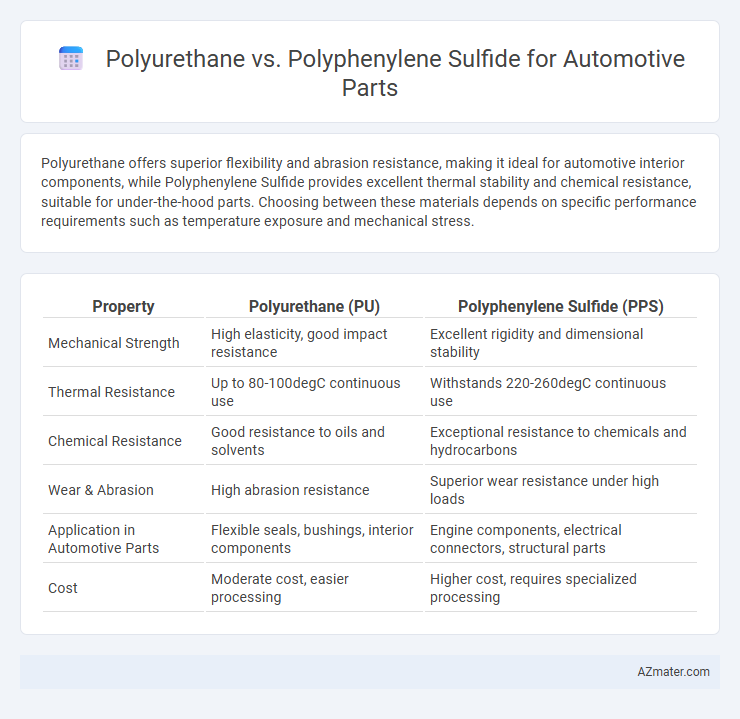Polyurethane offers superior flexibility and abrasion resistance, making it ideal for automotive interior components, while Polyphenylene Sulfide provides excellent thermal stability and chemical resistance, suitable for under-the-hood parts. Choosing between these materials depends on specific performance requirements such as temperature exposure and mechanical stress.
Table of Comparison
| Property | Polyurethane (PU) | Polyphenylene Sulfide (PPS) |
|---|---|---|
| Mechanical Strength | High elasticity, good impact resistance | Excellent rigidity and dimensional stability |
| Thermal Resistance | Up to 80-100degC continuous use | Withstands 220-260degC continuous use |
| Chemical Resistance | Good resistance to oils and solvents | Exceptional resistance to chemicals and hydrocarbons |
| Wear & Abrasion | High abrasion resistance | Superior wear resistance under high loads |
| Application in Automotive Parts | Flexible seals, bushings, interior components | Engine components, electrical connectors, structural parts |
| Cost | Moderate cost, easier processing | Higher cost, requires specialized processing |
Introduction to Polyurethane and Polyphenylene Sulfide
Polyurethane is a versatile polymer widely used in automotive parts due to its excellent flexibility, abrasion resistance, and impact absorption capabilities. Polyphenylene sulfide (PPS) is a high-performance thermoplastic known for its exceptional thermal stability, chemical resistance, and dimensional stability under harsh automotive conditions. Both materials play critical roles in automotive manufacturing, with polyurethane preferred for flexible components and PPS for high-temperature, structurally demanding parts.
Chemical Properties and Composition
Polyurethane exhibits excellent flexibility, abrasion resistance, and chemical stability due to its urethane linkages derived from polyols and diisocyanates, making it suitable for automotive seals and cushions. Polyphenylene sulfide (PPS) is a high-performance thermoplastic characterized by aromatic rings and sulfide linkages, providing superior thermal stability, chemical resistance, and dimensional stability for under-the-hood automotive components. The distinct chemical compositions determine polyurethane's elasticity versus PPS's rigidity and high-temperature endurance in automotive applications.
Mechanical Strength Comparison
Polyphenylene sulfide (PPS) exhibits superior mechanical strength compared to polyurethane (PU), making PPS ideal for high-stress automotive parts requiring rigidity and thermal stability. PPS maintains tensile strength above 70 MPa and flexural modulus near 3 GPa at elevated temperatures, outperforming PU's tensile strength of around 40 MPa and lower modulus under similar conditions. The enhanced stiffness and impact resistance of PPS contribute to improved durability and longevity in automotive applications exposed to harsh environments.
Temperature and Thermal Resistance
Polyphenylene sulfide (PPS) outperforms polyurethane in automotive parts requiring high temperature and thermal resistance, maintaining structural integrity at continuous use temperatures above 200degC. Polyurethane typically withstands temperatures up to 80-100degC but degrades faster under prolonged thermal stress, limiting its application in engine components and exhaust systems. PPS offers superior chemical resistance and dimensional stability, making it ideal for under-the-hood parts exposed to extreme heat and harsh environments.
Durability and Longevity in Automotive Applications
Polyurethane exhibits excellent abrasion resistance and elasticity, making it ideal for automotive parts exposed to dynamic stresses, while polyphenylene sulfide (PPS) offers superior thermal stability and chemical resistance, ensuring long-term durability in high-temperature under-the-hood applications. PPS maintains structural integrity over prolonged exposure to harsh chemicals and extreme temperatures, extending the lifespan of critical components like fuel system parts and electrical connectors. The combination of polyurethane's flexibility and PPS's thermal endurance provides automotive manufacturers with optimized material choices for maximizing durability and longevity in diverse automotive environments.
Weight and Density Differences
Polyurethane exhibits a lower density, typically around 1.2 g/cm3, compared to polyphenylene sulfide (PPS), which has a density near 1.35 g/cm3, making polyurethane lighter for automotive applications. This weight difference contributes to improved fuel efficiency and reduced vehicle emissions when polyurethane is used in parts such as interior components and flexible joints. Polyphenylene sulfide offers higher thermal and chemical resistance, but its increased density can lead to heavier automotive parts, affecting the overall vehicle weight balance.
Manufacturing and Processing Methods
Polyurethane offers versatile manufacturing methods such as injection molding, casting, and reaction injection molding (RIM), enabling complex shapes and rapid prototyping for automotive parts. Polyphenylene Sulfide (PPS) requires high-temperature extrusion and injection molding due to its thermoplastic nature, suitable for precision components with excellent chemical and thermal resistance. The processing of PPS demands specialized equipment capable of maintaining processing temperatures around 300degC, while polyurethane's broader processing temperature range enhances its adaptability in automotive applications.
Cost Analysis: Polyurethane vs Polyphenylene Sulfide
Polyurethane offers a lower material cost compared to polyphenylene sulfide (PPS), making it a cost-effective choice for automotive parts requiring flexibility and impact resistance. However, polyphenylene sulfide, despite its higher upfront cost, provides superior thermal stability, chemical resistance, and dimensional accuracy, which can reduce long-term expenses through enhanced durability and lower replacement frequency. Evaluating total cost of ownership favors PPS in high-performance applications, while polyurethane remains competitive for budget-sensitive, less demanding automotive components.
Common Automotive Parts Made from Each Material
Polyurethane is commonly used in automotive parts such as seat cushions, door panels, and suspension bushings due to its excellent flexibility, durability, and impact resistance. Polyphenylene sulfide (PPS) is favored for under-the-hood components like fuel system parts, electrical connectors, and transmission components because of its high thermal stability, chemical resistance, and dimensional stability. Both materials contribute to vehicle performance and longevity by meeting specific functional requirements in different automotive systems.
Environmental Impact and Sustainability Factors
Polyurethane offers versatility and lightweight properties but poses challenges due to its dependence on fossil fuels and limited recyclability, contributing to environmental concerns in automotive applications. Polyphenylene sulfide (PPS) demonstrates superior thermal stability, chemical resistance, and potential for recycling, making it a more sustainable choice for high-performance automotive parts. The environmental impact of PPS is lower over the product lifecycle, as it supports longer part durability and reduced emissions during manufacturing compared to polyurethane.

Infographic: Polyurethane vs Polyphenylene Sulfide for Automotive Part
 azmater.com
azmater.com